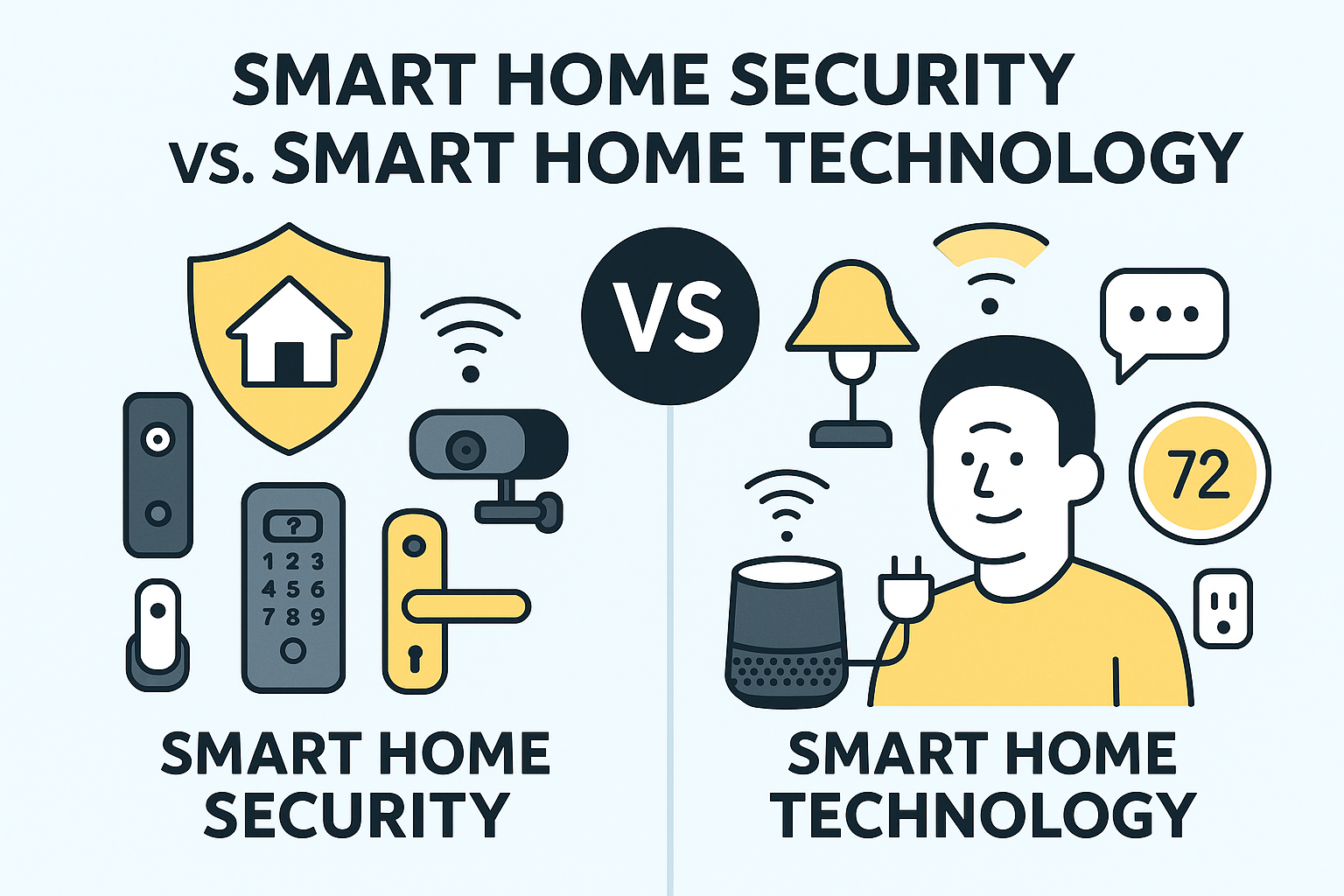
Smart Home Security vs. Smart Home Technology
In modern times, home protection is more critical than ever for living in a comfortable environment. Home owners can achieve this comfort through both smart home technologies and home security.
Smart home security vs smart home technology are distinct but related. Home security is like remote monitoring using devices like cameras or alarms. On the other hand, smart home technology is enhancing various aspects through automation.
What is Smart Home Security?
Never confuse home security with smart home technology as there exists a difference. Home security systems protect your properties from intruders through alarms and signals. On the other hand, smart home technology is more about automation, energy efficiency and convenience.
Home security is for peace of mind depending on the consumer’s needs, and driven by advanced technology. Recalling traditional security systems, there used to be burglar alarms or surveillance cameras for the professional monitoring services. In case of any security breach, these systems will deter intruders through the audible alarms. It has been around for decades, but their effectiveness and reliability is well-documented. It used to be an ideal choice for the households.
Internet, wireless communication and smart devices brought a significant shift towards smart home security systems for more enhanced security features. Motion detectors, door/window sensors or connected doorbells are some components of home security.
Obviously, smart systems have more advantages like real-time alerts or remote control via smartphones.
Key Components of a Smart Home Security System
Home security system components work simultaneously for your home protection and belongings starting from their entry points like windows and doors. Its major components include the following:
- Master control panel: Every smart home security has a master control panel, which is its base station or control unit. They have a digital touch screen, and are usually inserted inside the front door. They often have the date, time, weather, temperature, speaker and intercom. Smart home automation features are also part of them. Home security settings allow the homeowner to arm and unarm the system using the panic buttons.
Modern master control panels allow users to control the master control panel remotely using their smartphone.
- Indoor & Outdoor security cameras: This noticeable feature is useful in capturing the footage near and around home. Always install them strategically so the burglars can’t break the blind spot to enter your home. It records the footage of your home surroundings.
Indoor security camera captures views inside the home. Basically, they both provide a panoramic view of your home. They are durable and can’t be easily damaged by intruders or weather conditions.
- Doorbell Cameras: helps in identification of people coming near your home. Some of the noticeable features of doorbell cameras include real-time active alerts, video surveillance, two-way takh system for the home owner and person on the other side of the door as well as the live-stream video with your smartphone.
- Smart Locks: you can call them modern home burglar alarms powered by electronic keypad, mobile devices, biometric sensors, bluetooth, Wi-Fi signals and access card. It opens the lock receiving signals.
- Security sensors (glass break sensors) include the door and windows monitors attached with doors and windows. Alarm sounds when the door/windows open.
- Motion detectors: they measure indoor and outdoor movements by sending ultrasonic signals. Whenever the sensors detect unusual movement, the alarm powers on.
- Glass break detectors: will detect the sound of broken glass from a broken window/door in your home. These detectors listen to the unique sound system and report to the entire home-security.
- Safety alarms (detectors): alarms and protects against fire, excess water and smoke. Carbon monoxide and flood detectors are real-time alerts to protect you from life-threatening situations.
Home security solutions are highly customizable so create systems as per your needs, and integrate smart home devices in accordance to gain complete control of your home. Custom-built smart security offers flexibility and advanced features.
Smart Home Technology:
Smart home technology involves advanced devices and systems for home convenience and protection. Our kids are also familiar with voice-controlled Amazon-Alexa and Google Homes. Similarly, automated lighting, smart thermostats and other integrated appliances are common features of the smart home systems. It makes everyday tasks interconnected, efficient and accessible.
The smart-home technology is equipped with internet-connected devices allowing security features, appliances, and climate controls. Mobile devices operate them remotely using wireless systems.
Consumers can use these internet-connected home products including security cameras, video doorbells, smart entertainment speakers, smart locks, smart and connected thermostats as well as pet cameras.
How do smart homes work?
Smart home technology operates from a single central point including mobile, tablets, laptops or game consoles. One home automation system will control the appliances like door locks,thermostats, cameras, lights, TV and refrigerators.
Remote control systems help users to schedule tasks, trigger devices and monitor their results from anywhere.
Smart home automation systems inform the homeowners if any suspicious movement happens in home even if they are away.
Key Components of Smart Home Technology:
Heating:
Get greater control over heating devices including turning off and on of products. They have controlling settings with temperature and humidity sensors to automatically turn off and on the products. Now, these smart home innovations are extended to air conditioners.
Lightening:
Switch off and on lights remotely per schedule. Do settings based on sunrise and sunset times. Changes happen based on motion. Smart bulbs use Wi-Fi and display usage statistics for communication.
Automated blinds can be installed which closes based on sunrise schedules. Electronic curtains help in managing window blinds using a handheld device.
Audio/visual:
Smart home technology uses entertainment products connected together with a single remote. Through television and speakers, one can give them commands using applications. Operate them as per your schedule or by voice control.
Security:
Enhanced security capabilities are possible using the smart home products like track motion, capture videos and allowing video feeds for the live video. Sync it with the doorbell or set to capture them in certain areas of your property.
Advanced security kits include motion sensor detectors, home monitoring alerts and notifications concerning suspicious behavior. You can lock and unlock windows and doors remotely using smart home technology.
Installation of the smart home technology is customizable as per your requirements and needs. People interact with the products using voice and issuing commands. Smart smoke alerts and carbon monoxide detectors can be synced with the phone to alert you. The devices are useful for sending emergency notifications for every emergency responder.
Home internet requires only download and upload speed. Upload speed determines how fast we can send data out of the internet, and download speeds shows how fast you can pull data out of the internet.
Fiber internet comes with symmetrical upload and download speed; however, many ISPs offer plans with less upload speed than download speed. They typically offer 1 Mbps upload bandwidth for every 10 Mbps of download bandwidth.
Pros & Cons of Home Security and Smart Home Technology
Pros:
- Dedicated security systems have many advantages like professional monitoring for 24/7.
- Higher security standards are offered to meet security requirements against intrusions.
- Reliable emergency response is possible through the home security emergency.
- Security systems are reliable and practical choices for homeowners primarily concerned with safety and protection.
Cons:
- Installation expenses for home system
- Expensive than their not-so counterparts
- Maybe a steep curve for some non-tech savvy users
- Vulnerability to hackers creates need for vigilance.
Conclusion on Home Security vs Smart Home
Throughout this article, we have explored the major difference between smart home security and smart home technology. Both leverage the opportunity to enhance your living space security, but the primary objective is different. Smart home security is basically about protecting your property through professional monitoring, advanced sensors and integrated cameras.
Conversely, smart home technology offers more convenience and efficiency through automation. Voice-controlled lighting, smart thermostats to automated blinds create a more convenient and comfortable living environment; however, the smart home integration is the true power as it transforms the collection of individual devices into a cohesive ecosystem to enhance bothe safety and lifestyle.
Ready to enhance your home’s security? Explore and discover the possibilities of home integration to find a perfect system as per your lifestyle today !
FAQ
You have questions, we have answers
